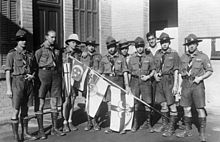Colonial scouts
The term colonial scouts is used to describe three scout associations from 1926 to 1933 that were linked by a common history. The aim of their work was to regain the German colonies lost in the First World War and to train emigrants. In mid-1933 the membership was around 5,000 scouts.
history
Since 1919, the German Colonial Society has been campaigning to win young people over to colonial ideas. When the " Kurmarkgau German Scouts" did not feel that they belonged to a scout association in 1925, they turned to the youth group of the German Colonial Society, which recommended them to the German Colonial Society . This took them on and founded the Colonial Association of German Scouts (KBDP) on August 5, 1926 .
August Döring was appointed federal leader by the German Colonial Association, but tensions arose between him and individual groups of the KBDP as early as 1927, which saw themselves as part of the Bundische Jugend and criticized the scouting work, which was based on the pre-war style of the German Boy Scout Association. As a result, the KBDP split on March 4, 1928 into the Association of German Colonial Scouts (BDKP) under the leadership of Ernst Klingelhage and the Colonial Association of German Scouts under Döring.
In 1928, both groups participated in the establishment of the "Foreign Office of the German Scout Associations", from which the German Scout Association emerged in 1929 , which aimed to join the German Scout Associations to the World Organization of the Scout Movement .
After Erhard Pörschmann took over the leadership of the KBDP in early 1931, the two leagues came closer together again. At the end of 1931, the merger was decided on December 12th in Braunschweig and on December 13th in Leipzig. Klingelhage became federal leader of the newly created German Colonial Boy Scout Association (DKPB), Pörschmann his deputy.
In the following year, the DKPB was intensely committed to voluntary labor service after individual groups from its two predecessors had already participated in previous years. At the federal camp on Whitsun 1932, the merger process was completed with the election of Werner Rohr as federal leader.
In March 1933, the DKPB briefly advised joining the Greater German Federation in order to avoid being forced into joining the Hitler Youth, but rejected this idea. Instead, the federal government placed itself under the patronage of Franz von Epps , who, as the National Socialist Reich Governor in Bavaria , was supposed to secure the existence of the DKPB within the framework of Nazi colonial policy . This tactic was unsuccessful: At its second and last federal camp , the DKPB was transferred to the Hitler Youth on August 1, 1933 . Larger groups formed largely independent "colonial groups" in the Hitler Youth until around 1935, while smaller groups had to join the general Hitler Youth.
distribution
Colonial scout groups existed throughout the Reich, with a focus on Brandenburg , the Rhineland and Saxony . Outside the German Reich there were groups in Austria - as in almost all German scout associations of the Weimar Republic . In addition, short-lived groups abroad were formed in the Brazilian state of Rio Grande do Sul , in Chile and in South West Africa .
Known members
- Peter Martin Lampel was a member of the BDKP from around 1930; he left the DKPB in June 1933 because he rejected the intended close ties to the Hitler Youth. With numerous magazine articles and art postcards, he had made a significant contribution to the public image of the colonial scouts.
- Kai-Uwe von Hassel later completed an agricultural and commercial training course and was a planting clerk in Tanganyika . In the post-war period he embarked on a career in politics and was Federal Minister of Defense from 1963 to 1966.
swell
- ^ Cross and Lily, No. 5 1933
- ↑ Do you actually know him? - Kai-Uwe von Hassel Wolf J. Bell; Berto Verlag Bonn 1965
literature
- Werner Kindt: Documentation of the youth movement. Volume III: The German Youth Movement 1920 to 1933. The Bündische Zeit. Diederichs, Düsseldorf 1974. ISBN 3-424-00527-4
- Rudolf Kneip : Youth of the Weimar period. Handbook of Youth Associations 1919–1938 . dipa-Verlag, Frankfurt / Main 1974. ISBN 3-7638-0211-8
- Oliver Schmidt: The Colonial Scouts - a youth association between propaganda and self-determination . In historical youth research. Yearbook of the Archives of the German Youth Movement NF 2/2005. Pp. 84-105. Wochenschau Verlag, Schwalbach / Taunus 2006. ISBN 3-89974-310-5
- Stephan Schrölkamp: Under the sign of the lily. Documentation . Berlin 1988
- Karl Seidelmann: The Boy Scouts in German Youth History (3 vol.):
- Vol. 1. Presentation . Hannover, Schroedel 1977. ISBN 3-507-38037-4
- Vol. 2.1. Sources and documents from the period up to 1945 . Hannover, Schroedel 1980. ISBN 3-507-38038-2
- Winfried Speitkamp: The youth work of the German colonial movement in the interwar period . In historical youth research. Yearbook of the Archives of the German Youth Movement NF 2/2005. Pp. 69-83. Wochenschau Verlag, Schwalbach / Taunus 2006. ISBN 3-89974-310-5
